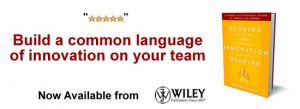The Do’s and Don’ts of Running an Ideation Program
 Do – Track Ideas
Do – Track Ideas
One of the first misses in an employe ideation system is not tracking ideas in the first place. There are a few reasons that this is important. First, building the organizational skill to effectively manage employee ideas takes time. It’s rare that a program to become an overnight success. For that reason, leveraging a maturity model for idea management is a good way to understand progress. But you need tracking in place to do that. The second reason is that it’s important to hold everyone accountable to the success of the program. That means tracking the idea from inception all the way to implementation – not just the idea itself. Some key things you can track are:
- Ideator
- Date the idea was submitted
- Date when key stakeholders (including ideators) received feedback on the idea
- Date idea was selected to be implemented
- Last update to key stakeholders
- Date the idea was completed
- Date the community was notified of the success of the idea
You can also download this Idea Tracker template to help you get started.
Don’t – Forget to respond to Ideas
Research shows that successful employe idea systems ensure that feedback is communicated to key stakeholders (including the ideator) in a timely manner. Failure to do so is actually the most frequently cited reason in studies as the main reason why idea systems fail. Responding to ideas is about responding to ones that you’ve selected but ALSO  the ideas that currently aren’t feasible.  Good feedback on accepted and declined ideas is one of the key factors that determine the success or failure of idea management programs. Read more about the key factors in the Employee Suggestion Box eBook.
Do – Engage leaders for support
We’ve seen employee idea programs begin as side-of-the-desk projects by highly engaged managers but for a side project to scale to a full organization, leadership support is essential. In our experience, we’ve seen that aligning your ideation program’s goals to business objectives is the most effective way to engage your leaders and show value. It is also critical for ensuring ideas will be able to secure resources needed to move through to implementation. If you’re not sure how to do this, check out the Idea Management Goal Setting Guide eBook which outlines exactly how to position your ideation program for leadership support.
Don’t – Add hurdles to submitting ideas
When first launching your ideation program, focus on making it easy for employees to submit ideas. Using idea software can significantly decrease friction in the process by allowing employees to submit their idea online or via a mobile app to a designated platform compared to submitting an idea in paper or via email. Research shows that online and more accessible ways of submitting ideas receive many more ideas that paper-based systems.
Do – Recognize (the right) Ideas
Research has shown that financial incentives don’t have an impact on the success of an employee idea program. In fact, it’s recognition that plays a more crucial role in the success of an ideation program. Recognizing ideas that you are looking for as two benefits. It helps employees model their ideas like the ones that are recognized creating a role-modelling effect. Second, it also increases engagement in the community to see their ideas succeed.
Don’t – Bottleneck Ideas
Sometimes central review committees are assembled to help evaluate ideas but more often than not, these committees actually become bottlenecks. They prevent ideas from moving forward because the sheer volume of ideas to evaluate is just too much even at small companies. Imagine  200 employee company with.5  ideas per person each month. That’s still 100 ideas to review! Build your governance structure so that you can effectively route ideas to the individuals who are in the best position to evaluate without any intermediaries.
Do – Be Patient
Creating an employee idea program that runs smoothly doesn’t happen overnight. Ideation, like all new skills, requires practice. Now imagine simultaneously training all of your employees on ideation. It is going to take time for your employees to get used to ideating and submitting ideas that you’re looking for. One way to help gauge expectation is using a maturity model (you can find ours in the Employee Suggestion Box ebook) so that you can adjust your success metrics as your program grows.
Don’t – Resort to Brainstorming to Get Ideas
Contrary to popular belief, brainstorming isn’t a great way to get ideas from groups of people. In fact, ideating individually generates more ideas than brainstorming in a group. However, it can be effective for improving an idea or building on an idea and reaching consensus. Read more about the best way to leverage brainstorming in this post on Best Practices for Brainstorming.
image credit: smallbiztrends.com
To learn more about the Maturity Model, read the Employee Suggestion Box: 10 Unexpected Factors separating Failures from High Performers guide.
Wait! Before you go…
Choose how you want the latest innovation content delivered to you:
- Daily — RSS Feed — Email — Twitter — Facebook — Linkedin Today
- Weekly — Email Newsletter — Free Magazine
 Jacqueline Zhou is the innovation expert at SoapBox Innovations, a SaaS innovation management company. An avid believer in tapping into the collective genius of communities, she shares her innovation insights on the SoapBox Innovations blog and @SoapBoxHQ
Jacqueline Zhou is the innovation expert at SoapBox Innovations, a SaaS innovation management company. An avid believer in tapping into the collective genius of communities, she shares her innovation insights on the SoapBox Innovations blog and @SoapBoxHQ
NEVER MISS ANOTHER NEWSLETTER!
LATEST BLOGS
Will the iPhone Come to T-Mobile?
Lost in the noise this week was an announcement of a settlement in a legal dispute in which Sprint agreed…
Read MoreHow Charity could help spread Innovation
Every once in a while innovations come along that offer profitable opportunities for the inventors and business minds that turn…
Read More




Thanks for this. Mostly enjoyed it. That being said, i very much disagree (from experience) with one of your DONTS (“Resort to Brainstorming”). I understand where you are coming from, and am very familiar with your stance, but have a totally different take on the phenomenon. While brainstorming should not be the ONLY approach to ideation, it can be a very effective approach, if done well (which is all too rare and probably why you include this in your DON’T category. Be careful not to make gross generalizations. https://www.huffingtonpost.com/mitch-ditkoff/in-defense-of-brainstormi_b_4851219.html